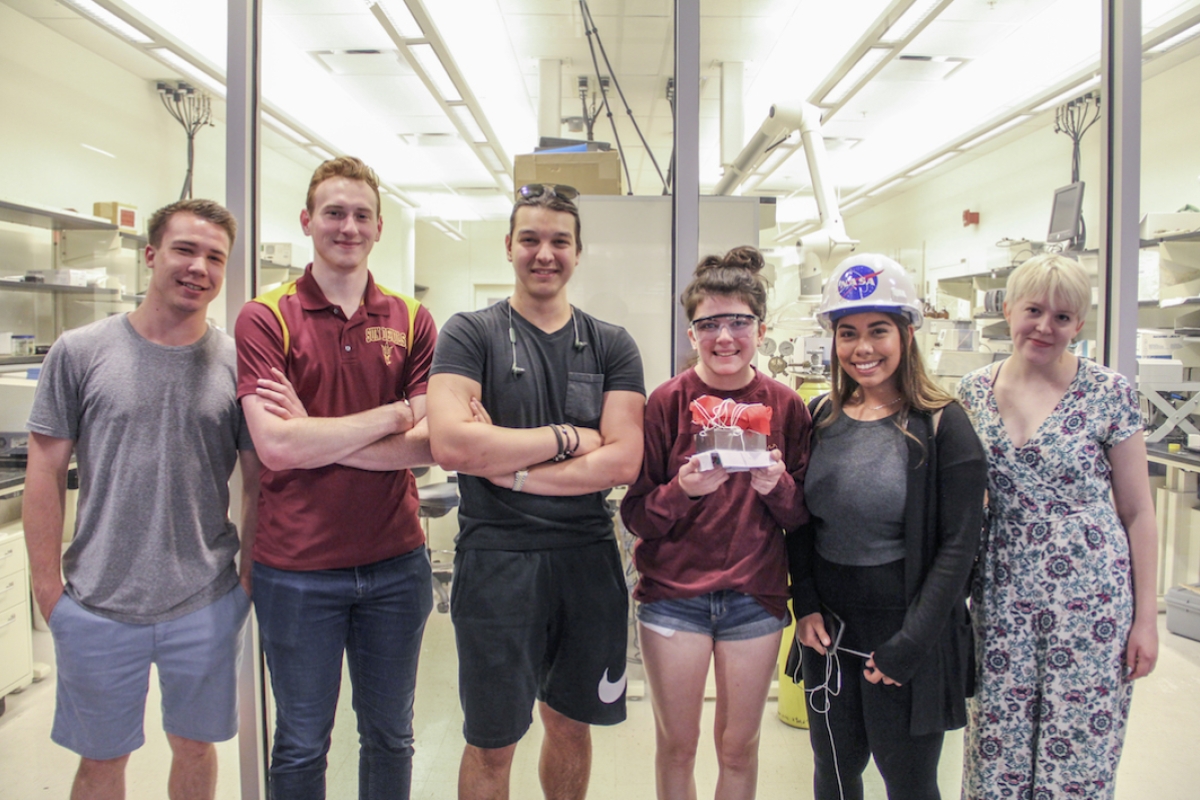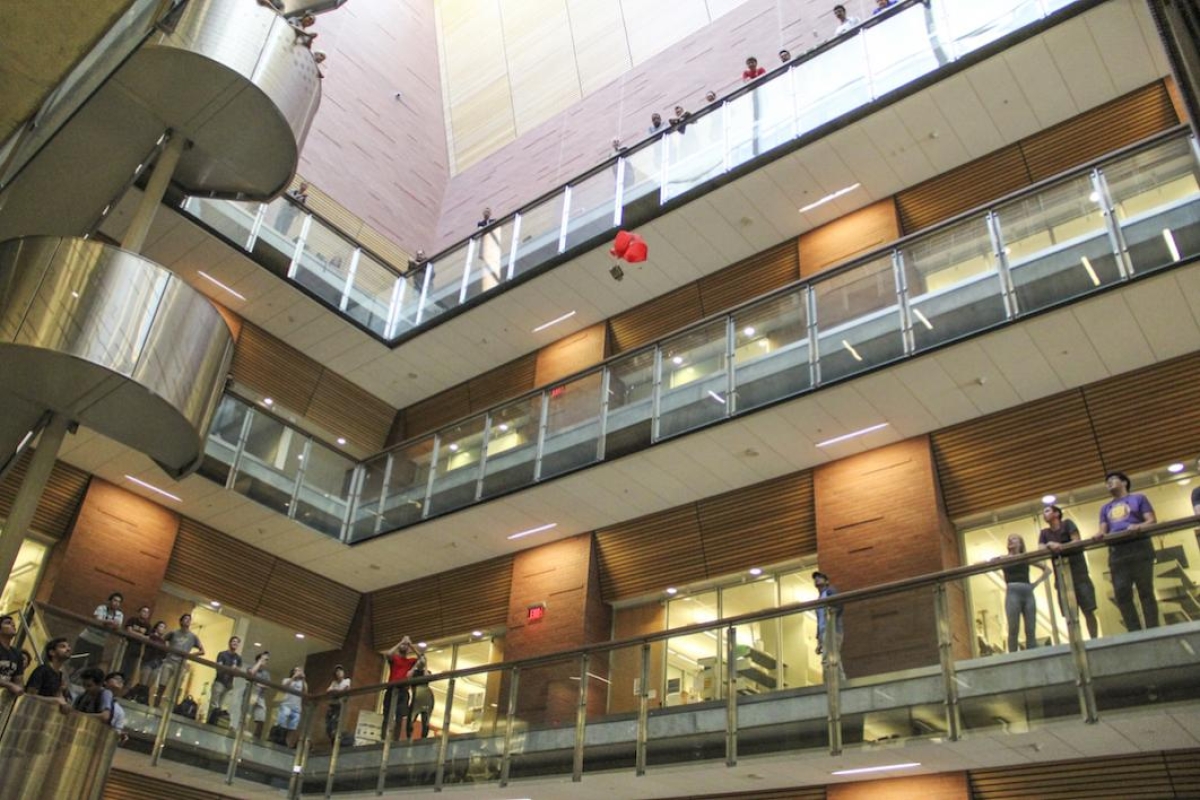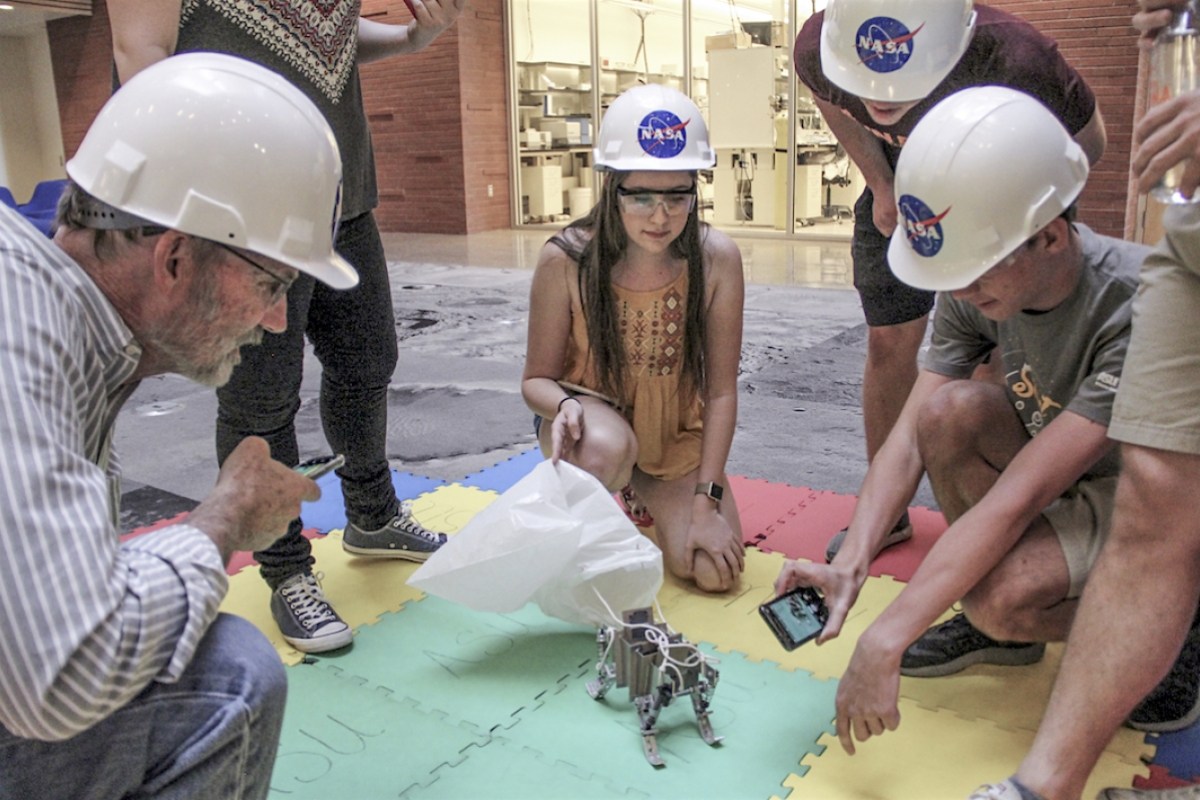L'SPACE program at ASU puts students on pathway to space workforce

Students Antonio Acuña and Hannah Stickel verify that the infrared sensor cover on their team's instrument project in Space Works 2 opens and closes with a control signal. Student teams in Space Works 2 and Space Works 3 must each design and build an instrument prototype that will operate in a vacuum simulating conditions in space. Photo by D. Garcia/ASU
A program at Arizona State University is starting undergraduate students on a career path that could lead them to join NASA spaceflight mission teams.
Funded at $5.04 million for three years by NASA, the program — dubbed L'SPACE (for Lucy Student Pipeline Accelerator and Competency Enabler) — is designed to attract space-exploration-minded college-level science and engineering students, both at ASU and across the country.
As its name suggests, the program is the student collaboration part of the Lucy mission. Lucy was selected through NASA's Discovery program of low-cost solar system missions. Based at the Southwest Research Institute in Boulder, Colorado, and planned for launch in 2021, the Lucy spacecraft will fly to Jupiter's Trojan asteroids and examine them at close range.
"We're training the next generation of prospective mission-savvy scientists and engineers," said Sheri Klug Boonstra, the L'SPACE lead at ASU, where the program is part of the School of Earth and Space Exploration. "All the student activities are structured to use actual mission practices, protocols, and procedures."
The L'SPACE program has several interlocking elements. The ASU Space Works Program engages science and engineering students enrolled at ASU through multi-semester capstone courses (Space Works 1 through 4) that center on students creating, building, and testing mission concepts. The program teaches them a wide variety of workforce development skills designed to launch them into careers related to space exploration.
"Being a part of the ASU Space Works program has reassured me that I am in the right place in my career," said Hannah Stickel, who will graduate from ASU in 2020 with a degree in aerospace engineering. "I gained so much experience through hands-on learning that will help me when I start looking for jobs."
But, Boonstra said, "the program is going way beyond ASU. It has another dimension that reaches nationwide."
L’SPACE Virtual Academy
Distance training is being accomplished through the national L’SPACE Virtual Academy. Linked through an online virtual network, teams of students — typically 10 in each — receive hands-on mission concept design challenges, which lead them to learn how to collaborate as team members to optimize a NASA-focused project. The skills they learn are crucial ones demanded by every space exploration mission.
"When I applied," said Helen Carson, who joined the online L'SPACE Virtual Academy from the University of Washington, "I had no idea how much the program would challenge and inspire me. I've learned not only about designing missions, but also about less obvious skills like writing professional documents and collaborating effectively."
As they work in teams over the 12-week courses, students deal with engineering constraints, budget challenges, design reviews, deadlines for deliverables and uncertainties regarding scientific return. They are faced with the same kinds of difficult decisions that actual teams experience in the course of preparing missions.
Boonstra explained, "These reality-based exercises help students approach projects in a professional way. Their experiences help make them more marketable as new graduates and valuable in terms of what they can do when they enter the workforce."
The L’SPACE Team at ASU is implementing this in partnership with the Lucy Mission Team at the Southwest Research Institute, NASA's Goddard Space Flight Center, Lockheed Martin, the Johns Hopkins University Applied Physics Laboratory, KinetX, Lucy co-investigator team members and other NASA experts.
To gain a diverse participant pool, students are being recruited from science and engineering organizations and NASA programs that work with underserved groups. These include the NASA Minority University Research and Education Program (MUREP), Society for Advancement of Chicanos/Hispanics and Native Americans in Science, the Society of Women Engineers, the Society of Hispanic Professional Engineers, NASA Space Grant, NASA Community College Aerospace Scholars and other institutions of higher education.
As of spring 2019, more than 750 students from 46 states and 299 universities have joined the program. Online L'SPACE Academy courses start three times a year, in January, May and September. To apply or to get more information, go to https://lspace.asu.edu.
Lucy mission
The Lucy mission is named after the early hominid fossil discovered by Donald Johanson and Tom Gray in the 1970s. The mission's principal investigator is Harold Levison, a planetary scientist whose research focuses on early solar system development.
"The Trojans are leftover remnants from when the solar system formed," Levison said. "They are preserved in two gravitationally stable clouds orbiting the sun at the same distance as Jupiter. The Lucy mission will sample a diverse set of Trojans that covers a broad range of color, size, rotation and likely other physical properties. In this way, Lucy will provide a better basis for understanding what the early building blocks of planets may have been."
Besides the L'SPACE program, ASU has an additional connection to the Lucy mission. The Lucy Thermal Emission Spectrometer (L'TES for short) is being designed and built on campus at the School of Earth and Space Exploration under the direction of Philip Christensen, Regents' Professor of geological sciences.
"L'SPACE provides an experience in workforce development that's hands-on, immersive and in step with what the students will encounter in the real world after graduation," Boonstra said. "This program will better prepare them to meet the challenges that await as we push our quest for knowledge across the solar system."
Christensen said, "Within the next 5 years, 46% of NASA's workforce will be at retirement age. I think this program offers a great opportunity for students to acquire hands-on skills and experiences that will give them a boost when they graduate and give them traction towards becoming the next generation of explorers."
More Science and technology

ASU professor breeds new tomato variety, the 'Desert Dew'
In an era defined by climate volatility and resource scarcity, researchers are developing crops that can survive — and thrive —…

Science meets play: ASU researcher makes developmental science hands-on for families
On a Friday morning at the Edna Vihel Arts Center in Tempe, toddlers dip paint brushes into bright colors, decorating paper…

ASU water polo player defends the goal — and our data
Marie Rudasics is the last line of defense.Six players advance across the pool with a single objective in mind: making sure that…




